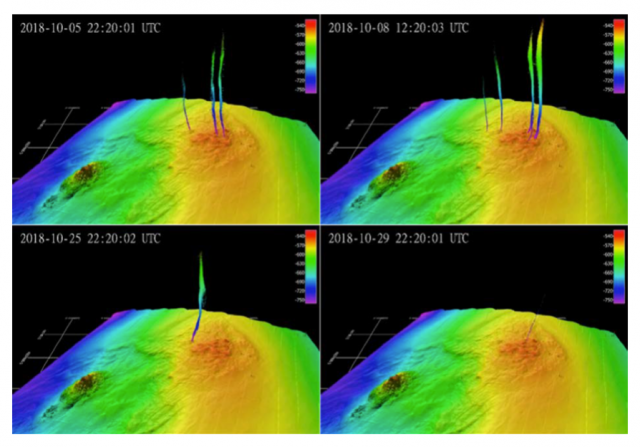Long-Term Monitoring of Gas Emissions at Southern Hydrate Ridge
Yann Marcon, MARUM – Center for Marine Environmental Sciences, University of Bremen, D-28359 Bremen, Germany. Extracted from OOI Science Plan, 2021
Natural methane gas release from the seafloor is a widespread phenomenon that occurs at cold seeps along most continental margins. Since their discovery in the early 1980s, seeps have been the focus of intensive research, partly aimed at refining the global carbon budget (Judd and Hovland, 2007). The release of gaseous methane in the form of bubbles is a major vector of methane transfer from the seabed to the water column (Johansen et al., 2020), of which the magnitude remains poorly constrained. Methane bubble plumes cause strong backscattering when ensonified with echosounders, and there are several studies that have used sonars to monitor deep-sea gas bubble emissions (Heeschen et al., 2005; Greinert, 2008; Kannberg et al., 2013; Römer et al., 2016; Philip et al., 2016; Veloso‐Alarcón et al., 2019).
Most previous studies relied on repeated discrete surveys with ship-echosounders or on short-term continuous monitoring with autonomous, battery- powered hydroacoustic platforms to study the dynamics of gas emissions and concluded that the intensity of the bubble release is generally transient. However, the timescales and the reasons for the variability are still poorly known. This knowledge gap is largely due to a lack of systematic monitoring data, acquired over longer periods of time (months to years). Identifying the parameters that control or influence the seabed methane release is important in order to refine our understanding of the carbon cycle.
Located at 800 m water depth on the Cascadia accretionary prism offshore Oregon, Southern Hydrate Ridge (SHR) is one of the most studied seep sites where persistent, but variable gas release has been observed for more than 20 years. The OOI’s Regional Cabled Array (RCA) supplies power and two-way communications to SHR, providing a unique opportunity to power long-term monitoring instruments at the summit of this highly dynamic system.
In 2018 and 2019, during the University of Washington RCA cruises, rotating multibeam and single beam sonars, a CTD instrument, and a 4K camera from the MARUM Center for Marine Environmental Sciences of the University of Bremen, Germany, were connected to the array to monitor gas emissions and seepage-related features at the SHR (Bohrmann, 2019). The sonars collected data at a much higher sampling rate than previous studies at SHR, and were at the site for several months (Marcon et al., 2019). An overview sonar detects active gas emissions over the entire SHR summit every two hours. A quantification sonar monitors seafloor morphology changes and the strength of selected gas emissions at an even higher sampling rate (Ts < 30 min). A 4K camera provides ground truthing images used to facilitate the analysis of sonar observations and new information on the dynamics of seabed morphology changes. Finally, a CTD instrument measures environmental parameters to allow the possible correlation of long-term parameter changes, possibly driven by the climate.
Preliminary results show that the location and size of the bubble plumes at SHR vary considerably over time (Fig. to the right) and indicate that a correlation may exist between more intense bubble release and lower bottom-water pressure. This implies that tides may partially influence methane bubble release activity at SHR. Seafloor images reveal that seepage activity triggers significant changes in seafloor morphology and biological communities, which may also explain part of the bubble plume variability.
High resolution and bandwidth ocean observing data from myriad, collocated instrument arrays, such as those provided by the RCA, are crucial to building timeseries spanning months or years that are required to quantify the flux of methane from the seafloor, possible impacts of ocean warming and seismic events, and the evolution of these highly dynamic environments. Short term or nonsystematic monitoring systems do not provide enough data to produce statistical correlations, nor detect low-frequency cycles with high degrees of confidence. In the years to come, we plan to achieve longer time-series to detect potential non-periodic, low-amplitude influences, possibly from climatic forcing. Such influences can only be reliably inferred with the kind of long-term. systematic sampling methodology made possible by the OOI observatory.
This work is funded by the German Ministry of Education and Research (Bundesministerium für Bildung und Forschung), grant numbers 03F0765A and 03F0854A.

